Apr 26, 2015 | coins, currency, legislative, policy
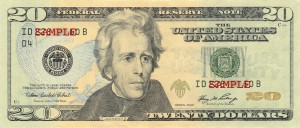 A few weeks after the Women on 20s group began their campaign, they gained the attention of congress to have two bills submitted to require the change be made.
A few weeks after the Women on 20s group began their campaign, they gained the attention of congress to have two bills submitted to require the change be made.
First up is Sen. Jeanne Shaheen (D-NH) who introduced Women on the Twenty Act (S. 925) on April 14, 2015 and referred to the Committee on Banking, Housing, and Urban Affairs, the bill is eight co-sponsor. All eight co-sponsors are Democrats and six are women.
Simply, the bill seeks to add a new paragraph to the Federal Reserve Act (12 U.S.C. § 418) to say:
The Secretary of the Treasury shall convene a panel of private citizens of the United States to advise and make recommendations to the Secretary regarding the likeness of a woman to appear on the face of $20 Federal reserve notes. In carrying out the requirements of the preceding sentence, each of the Secretary and the panel shall consider and weigh input provided by the American people.
While you read that paragraph, you have to understand that there is a little Washington-speak in the proposed law. All it says is that the Secretary is required to appoint a panel of private citizens, not government employees or appointees, to make a recommendation. It does not say that the Secretary is required take the committee’s recommendation nor does it it say that the Secretary is to do anything with the recommendation.
Essentially, unless the wording is changed, there is nothing in the above statement to require a woman appear on the $20 Federal Reserve Note. “Thank you for your recommendation,” a Secretary of the Treasury can say, “and have a nice day.”
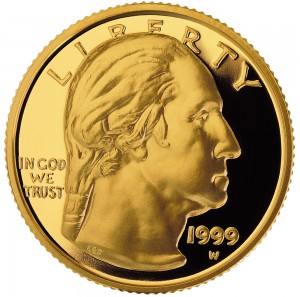
1999-W George Washington Commemorative using the design by Laura Gardin Frazer
Adding to the fray is a bill introduced by Louis Gutierrez (D-IL) whose title currently appears similar to that of Sen. Shaheen’s bill. Gutierrez’s bill (H.R. 1910) has no co-sponsors and was assigned to the House Financial Services Committee. As this is being written, the bill has not been published by the Government Printing Office making it difficult to compare this with S. 925.
Considering my last post about this topic, it will be interesting to see how this turns out. If I was to guess, one of the bills will be passed at the end of a session either by unanimous consent or an overwhelming vote in favor. A design will be produced but not in time to celebrate the 100th anniversary of suffrage. The wheels of politics and bureaucracy moves too slow and the engravers need time to engrave the plates.
Currency image courtesy of Wikimedia Commons.
Coin image courtesy of the U.S. Mint.
Apr 18, 2015 | coins, gold, legal, news, US Mint
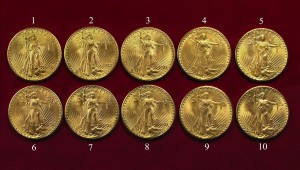
The ten 1933 Saint-Gaudens Double Eagles confiscated by the government from Joan Lanbord, daughter of Israel Switt.
The original suit was filed in the U.S. District Court in Philadelphia by Barry H. Berke on behalf of Joan Langbord, the surviving daughter of jeweler Israel Switt, and her sons Roy and David. Berke is no stranger to these types of law suits. He represented the plaintiffs in the case that resulted in the sale of the Farouk coin in 2002. In July 2011, the jury returned a verdict declaring the coins to be government property.

1974-D Aluminum Cent (J2151)
This case is different since it is further along and about what was to be a circulating coin.
The ruling, written by Judge Marjorie O. Rendell,† centers around the government’s use of Civil Asset Forfeiture Reform Act of 2000 (CAFRA). CAFRA was passed as a “eact[ion] to public outcry over the government’s too-zealous pursuit of civil and criminal forfeiture” and as an “effort to deter government overreaching.” The government said that the Langbords did not file their suit within the 90-day time period. However, the ruling says that it does not imply because “Congress has specifically enumerated theft or embezzlement of government property as one of the crimes to which CAFRA applies.” Since the government called the assets stolen and then ignored the Langbords’ claim for the government to return the coins, they did not prove that the assets were embezzled and CAFRA does not apply.
In the areas where CAFRA did apply, the government did not respond to the Langbords’ request for return of the assets within the 90-days required by law. “The Langbords are correct in urging that we reject these arguments. The Government was required either to return their property or to institute a judicial civil forfeiture proceeding within 90 days of the Langbords’ submission of a seized asset claim.”
The three judge panel concluded “he Langbords are entitled to the return of the Double Eagles.” The appeal overturns the lower court’s ruling and the Appeals Court “will remand for the District Court to order the Government to return the Double Eagles to the Langbords.”
This may not be the end of the story. The government can ask for a temporary stay of the order in order to file an appeal. At that point the government attorneys can either appeal the ruling by the three-judge panel to the full Appellate Court (a full 9 judge panel) or directly to the Supreme Court.
My opinion: considering how the government has behaved throughout the saga of these coins, I think they will try to appeal this ruling to the full Third Circuit. It drags the case out longer and allows the government to put its considerable heft against the the Langbords. I do not think the government will settle this suit in a similar manner that the King Farouk coin was settled. However, if I understand the procedures correctly, the Langbords can claim that the case has significant public interest and ask for it to be heard by the Supreme Court. The Supreme Court then will decide to hear the case or let it be heard by the Third Circuit first. Regardless, I think the next stop is the Supreme Court where the most fascinating story in U.S. numismatics will be settled.
Or will it?
† Judge Rendell was appointed by President Bill Clinton in 1997. She was also the First Lady of Pennsylvania during the term of her then husband
Ed Rendell (2003-2011). The Rendells have since “
amicably separated.”
Image of the 10 Double Eagles courtesy of the U.S. Mint.
Image of the Aluminum cent originally from the Smithsonian Institute.
Apr 17, 2015 | BEP, coin design, currency, dollar, Federal Reserve, news
 During the course of searching for information, I stumbled upon the website for Women on 20s. It is a site dedicated to replacing the image of President Andrew Jackson with a woman by 2020. The group has targeted the $20 Federal Reserve Note to be replaced 2020 because it is the 100th anniversary of the passage of the 19th Amendment that granted women the right to vote.
During the course of searching for information, I stumbled upon the website for Women on 20s. It is a site dedicated to replacing the image of President Andrew Jackson with a woman by 2020. The group has targeted the $20 Federal Reserve Note to be replaced 2020 because it is the 100th anniversary of the passage of the 19th Amendment that granted women the right to vote.
Jackson is being targeted because as we look back through the long lens of history, he was not exactly a model person judging by today’s standards. During the War of 1812, Jackson led U.S. Army troops against native tribes working with the British against the United States to regain the lands taken following the colonies’ independence. It was said that Jackson’s troops were brutal against the native tribes on his orders, killing them rather than taking prisoners.
After beating back the British in the Battle of New Orleans, Jackson declared martial law in New Orleans and used his troops to enforce martial law. Aside from having a magistrate arrested who sided with a newspaper reporter writing who was arrested for writing negatively about his rule, he had members of the local militia who sided with the British executed without trial and went on to use it as propaganda to allegedly maintain order.
As president, Jackson’s policies to relocated native tribes lead to the Indian Removal Act that codified his policies. This lead to the “Trail of Tears” that forced the relocation of Cherokee, Muscogee, Seminole, Chickasaw, and Choctaw nations from their ancestral homelands in the southeast to an area west of the Mississippi River that had been designated as Indian Territory. It is considered the most violent and brutal act against the native tribes in United States history.
To have Jackson’s portrait on the United States central banks’ currency is also a bit ironic. Jackson was against the concept of a central bank and refused to renew the charter of the Second Bank of the United States and vetoed the bill to continue its charter. After winning election in 1833, Jackson withdrew all of the country’s funds from the bank limiting the bank’s ability to conduct business. He gave power to local banks to lend money and issued the Specie Circular, an executive order requiring government transaction be done in gold and silver coin (specie).
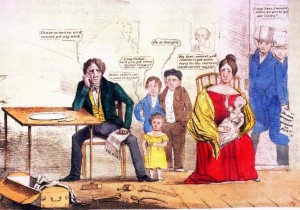
Poster issued by the Whig Party blaming Jackson for the Panic of 1837
The Women on 20s organization does not believe that this should be the legacy honored on U.S. currency. But if we look into the history of all of the men on U.S. currency, there are aspects of their pasts and personal lives that would make some blush, including Benjamin Franklin’s common law wife and illegitimate son.
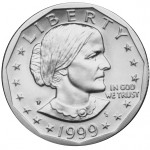 Women on 20s do recognize that suffragette Susan B. Anthony did appear on a one dollar coin but the coin failed because of its confusion with the quarter. They also recognize that Sacagawea, the Shoshone guide to Meriwether Lewis and William Clark, appears on the current one-dollar coin. Aside from the 2003 Alabama State Quarter, no other woman has appeared on circulating coinage (they do not count commemorative issues). Since neither dollar coin has circulated well and since the Alabama quarter was a temporary issue, the organization believes a better tribute is warranted.
Women on 20s do recognize that suffragette Susan B. Anthony did appear on a one dollar coin but the coin failed because of its confusion with the quarter. They also recognize that Sacagawea, the Shoshone guide to Meriwether Lewis and William Clark, appears on the current one-dollar coin. Aside from the 2003 Alabama State Quarter, no other woman has appeared on circulating coinage (they do not count commemorative issues). Since neither dollar coin has circulated well and since the Alabama quarter was a temporary issue, the organization believes a better tribute is warranted.
In what looks like an addendum to their argument, they mention that a portrait of Martha Washington appeared on the Series 1886 (Fr. #215) and 1891 (Fr. # 223) $1 Silver Certificates. Both Martha and George Washington appeared on the reverse of $1 Series 1896 Educational Series note (Fr. #224).
To decide who they will try to lobby to appear on the $20 note, the organization started with 15 candidates. Voters were asked to select thee of the 15 candidates in this preliminary round. The top vote-getters will be subject to another final voting round.
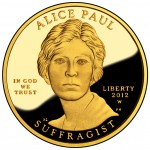
2012 First Spouse coin featuring Alice Paul
Women on 20s reported that 256,659 people had cast ballots when the first round ended on April 5, 2015. They reported that Eleanor Roosevelt, Harriet Tubman and Rosa Parks were named by as many as half of the voters as one of their top three. They added Wilma Mankiller to the final ballot. Mankiller, the first female Chief of the Cherokee Nation and the first female to be a chief of a native nation, was added because of a claimed “strong public sentiment that people should have the choice of a Native American to replace Andrew Jackson.”
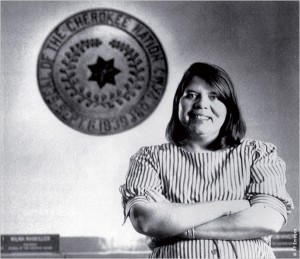
Wilma Mankiller, the first female principal chief of the Cherokee Nation
Voting is open at the time this is being written. There is no closing date listed on their website.
Since congress does not control the design of the currency, Women on 20s will have to convince the Federal Reserve to change the design of the $20 Federal Reserve Note. If the Federal Reserve, whose chair is Janet Yellen, agrees to the change, they will work with the Bureau of Engraving and Printing for the design and the U.S. Secret Service to ensure that the appropriate anti-counterfeiting measures are included.
Design changes to any Federal Reserve Note can take 3-5 years to complete.
NOTE: I contacted the Women on 20s organization for comments via email. That email has not been returned at the time of writing this article. If they answer my questions, I will publish them in a follow up post.
Image of the $20 FRN and Whig Party poster courtesy of Wikimedia Commons.
Coin images courtesy of the U.S. Mint
Image of Wilma Mankiller courtesy of the
Native American Encyclopedia.
Apr 15, 2015 | cents, coins, commemorative, currency
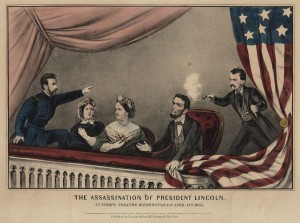
Lithograph depicting Lincoln’s Assassination by Currier and Ives.
Joining the crowd in the room was Surgeon General of the United States Army Joseph K. Barnes, his assistant Charles Henry Crane, Lincoln’s personal physician Dr. Robert K. Stone, and Dr. Anderson Ruffin Abbott the first Black Canadian to be a licensed physician. With Barnes in charge, the examination and treatment proved beyond the capabilities of the medical arts of the time. By 7:22 AM on April 15, 1865, Abraham Lincoln, the 16th President of the United States of America had succumbed to his injuries.
While every president faces their shares of challenges, Abraham Lincoln was challenged with the morality of slavery and the breaking apart of the republic before it reached its 100th anniversary. He was so concerned about keeping the nation together that not only did he have Union troops shoot at what he considered fellow Americans, but he broke laws and violated the constitution in order to keep the country going.
Lincoln is remembered for his debates with Stephen Douglas, the Emancipation Proclamation, Gettysburg Address, his second inaugural address, the Civil War, the Homestead Act, three revenue-based (taxation) acts, and the National Banking Act that lead to the creation of the Bureau of Engraving and Printing. Aside from being the first president assassinated, there are other aspects of his presidency that is not widely discussed. Lincoln was known for either not enforcing laws he did not like or over enforcing laws to silence critics. While he did not condone a lot of the brutality especially from Generals Sherman and Grant, he did not condemn them either. Some historians suggest that his appointment of the young General George B. McClellan after the loss at the First Battle of Bull Run was to use him to manipulate the strategy to be more brutal against the Confederacy.
In a move that would have had any modern president excoriated, Lincoln ignored a writ of habeas corpus issued by Supreme Court Chief Justice Roger B. Taney. Lincoln became incensed with Taney after he authored the controversial Dred Scott v. Sanford decision that Lincoln highly disagreed with. Following the writ, Lincoln and his cabinet ignored Taney, a move that hurt him in many ways. Taney died miserable and poor after a long illness blaming Lincoln for his decline.
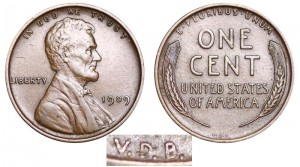
1909-VDB Lincoln Cent
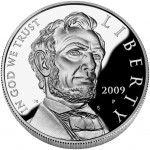
Obverse of the 2009 Abraham Lincoln Commemorative proof coin
At one time there was a trivia question as to the only United States coin with a presidential portrait of a president on both sides of the coin: the Lincoln Memorial cent. If you look carefully in the memorial on the reverse, you can see the statue of Lincoln in the memorial making it the only coin of its time to have this distinction.
Aside from appearing on the current $5 Federal Reserve Note, Lincoln has appeared on notes of 10 different designs and denominations including the fourth issue 50-cents fractional note, $10 Demand Note, $500 Gold Certificate, and a $1 large size silver certificate.

Series 1882 $500 Gold Certificate
In honor of Lincoln, spend at least one of those little copper-coated zinc cents remembering that if it was not for him, that coin might not have existed.
Curier & Ives image courtesy of the Smithsonian Institute.
Image of the 1909-VDB cent courtesy of
USAcoinbook.com.Image of the 2009 Lincoln commemorative dollar courtesy of the U.S. Mint.
Banknote image courtesy of
AntiqueBanknotes.com.
Apr 10, 2015 | cents, coin design, coins, economy, news, US Mint
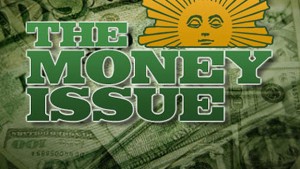 The U.S. Mint has sent out a press alert saying that CBS Sunday Morning will air two segments this Sunday, April 12th, that may be of interest to collectors. The first segment will focus on the artists and engravers in Philadelphia and the role they play in the coin-making process. The segment will also look at some of the Philadelphia Mint’s history.
The U.S. Mint has sent out a press alert saying that CBS Sunday Morning will air two segments this Sunday, April 12th, that may be of interest to collectors. The first segment will focus on the artists and engravers in Philadelphia and the role they play in the coin-making process. The segment will also look at some of the Philadelphia Mint’s history.
A second segment will look at the penny and the debate about whether or not it should be eliminated.

Anthony Mason
CBS Sunday Morning is usually hosted by Charles Osgood and airs at 9 am Eastern Time. Check your local listings to see when it airs in your region.
Apr 9, 2015 | BEP, currency, history, policy
NOTE: I am doing research into the policies that create our money. This is not a look into the economic policies but what happened after the economic policies are executed. For this series of articles, I wanted to know what happened after it was decided that the country would sell bonds in order to fund the Civil War. This is a summary of some of the research to answer one question and tie it in with history.
First of three parts.
Did you ever want to know how or why something was done but there was no answer? Or there may have been answers but nothing definitive that would make any of the answers true? It is this type of curiosity that had me searching for the answer to one question:
Why is the greenback green?
There are references that claim that the green printed back was to differentiate the currency of the United States from those from other countries. Other references call it an anti-counterfeiting mechanism. Neither claim can tie themselves to the actual events in such a way that we can say which is the truth. Or can we?
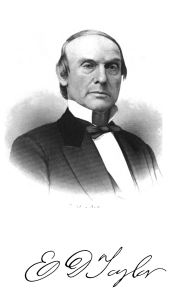
Col. Dick Taylor
Shortly after Taylor’s birth, the entire Taylor family moved to Kentucky because of exhausted lands in southern Virginia. They settled along the Ohio River outside of Louisville. In 1814, Giles moved his family Shawneetown, Illinois as one of the area’s pioneer settlers. Unfortunately, Giles died shortly thereafter leaving the family of little means.
Preferring to be called by his middle name, Taylor would be referred to by the common nickname of Dick and began travelling throughout the Midwest region to earn a living. At this time he would sign his name as “E.D. Taylor.” Dick Taylor demonstrated a lot of skill in organizing while operating as a trader on the frontier. By 1929, Taylor settled in Springfield, Illinois and married Margaret Taylor, the daughter of Col. Richard Taylor and sister of then Col. Zachary Taylor.
When the Black Hawk War broke out in 1831, he enlisted in the Illinois infantry and appointed as a colonel by the governor where he served with Jefferson Davis, General George Jones, and General Henry Dodge. Following the war he was elected to the Illinois House of Representatives then, after one term, was elected to the senate defeating a long-standing senator.
Taylor ran his senate campaign on a platform to move the capital from Vandalia to Springfield. To accomplish this, Taylor wrote a bill and worked with a representative named Abraham Lincoln, whom he met as a shopkeeper in New Salem. The bill was successful and Springfield has been the capital of Illinois since.
Taylor was a master at managing money and served the state in many capacities. In 1835, Taylor was appointed Receiver of Public Moneys in Chicago. Today, that position would be known at the comptroller. Under Taylor’s guidance, Chicago managed land sales better than any other city in the country and grew Chicago into the second largest city in the United States passing Philadelphia for that distinction. He was so well regarded in Washington, that not only did President Andrew Jackson hold a special dinner in Taylor’s honor, but appointed him to the commissions that oversaw the building of railroads in the upper Midwest.
With his connections from Springfield and working with Jackson, who is considered the father of the modern Democratic Party, Taylor became a member of the party and helped build the political machine that continues to run Chicago today. He was a friend and staunch supporter of Stephen A. Douglass and would travel the state stumping for Democratic candidates.
Taylor did not forget his friendship with Lincoln. Even though Lincoln had joined the then nascent Republican Party, he would also campaign with his friend in areas that were not strong Democratic strongholds. But for the presidential election of 1860, Taylor supported Douglas and campaigned throughout Illinois against Lincoln.
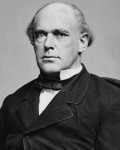
25th Secretary of the Treasury Salmon P. Chase
Knowing how Taylor turned around the finances of Chicago and then the railroad alliance, Lincoln turned to his old friend for advice. Taylor convinced Lincoln to ask congress to issue currency backed by the bonds but with no interest. Using what he learned in managing tickets sales for the railroads, Taylor provided Lincoln the outline for a currency system that was adopted with much reluctance by Chase.
First published in Abraham Lincoln, author Emil Ludwig found a letter acknowledging Taylor as the person who came up with the idea:
My dear Colonel Dick:
I have long determined to make public the origin of the greenback and tell the world that it was Dick Taylor’s creation. You had always been friendly to me. and when troublous times fell on us, and my shoulders, though broad and willing, were weak, and myself surrounded by such circumstances and such people that I knew not whom to trust, then I said in my extremity, ‘I will send for Colonel Taylor — he will know what to do.’ I think it was in January 1862, on or about the 16th, that I did so. Said you: ‘Why, issue treasury notes bearing no interest, printed on the best banking paper. Issue enough to pay off the army expenses and declare it legal tender.’ Chase thought it a hazardous thing, but we finally accomplished it, and gave the people of this Republic the greatest blessing they ever had — their own paper to pay their debts. It is due to you, the father of the present greenback, that the people should know it and I take great pleasure in making it known. How many times have I laughed at you telling me, plainly, that I was too lazy to be anything but a lawyer.
Yours Truly.
A. Lincoln
Lincoln, not one to miss an opportunity, used his executive authority to begin the production of a national paper currency in the form of Demand Notes as an extension of the Act of July 17, 1861 (12 Stat. 259) that authorized the printing of fractional currency.
Since the federal government did not have printing facilities, the law was written to allow notes to be produced by a “New York bank note company.” The first four issues fractional currency were printed by the American Banknote Company and the National Banknote Company. By the fifth issue, the new Bureau of Engraving and Printing began to print these notes.
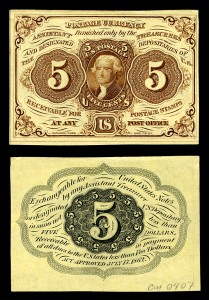
First issue: 5-cents, Thomas Jefferson (Fr. #1231)
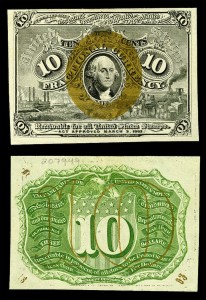
Second issue: 10-cents, George Washington (Fr. #1246)
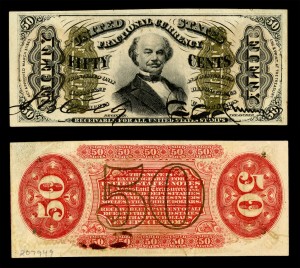
Third issue: 50-cents, Francis Spinner (Fr. #1328)
To save time and money, the first series of notes were printed four and six to a sheet in New York then shipped to Washington where the Treasury set up the Office of the Currency Comptroller to manage. As par of the OCC, the National Currency Bureau was created to do the cutting, bundling, and distribution of the currency.
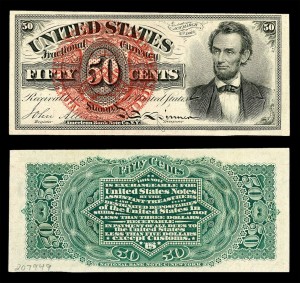
Fourth issue: 50-cents, Abraham Lincoln (Fr. #1374)
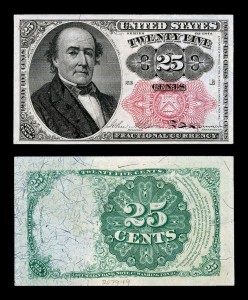
Fifth issue: 25-cents, Robert Walker (Fr. #1308)
The process for the United States to print its own currency had begun. While Secretary Chase was leading the plan to build a printing operation, congress authorized Treasury to establish an engraving and security printing bureau. That law was approved on July 11, 1862 (12 Stat. 532). With construction for a printing facility underway, Treasury hired James Duthie as the first engraver. Although he was a temporary engraver, he was provided a $1,600 per year salary (the equivalent to just under $38,000 in current dollars).
In Part 2 we introduce you to a little known geologist who may have developed more than the theory of the greenhouse effect.
References:
- Conrad, Howard Louis. “The Originator Of Greenback Currency: Colonel Edmund Dick Taylor.” The National Magazine, June 1892, 209-14.
- Ludwig, Emil, Eden and Cedar Paul (translators). Abraham Lincoln. Boston: Little, Brown, 1930.
- Mitchell, Wesley C. A History of the Greenbacks, with Special Reference to the Economic Consequences of Their Issue: 1862-65. Chicago: University of Chicago Press, 1903.
- History of the Bureau of Engraving and Printing, 1862-1962. Washington: Treasury Dept.; 1964.
- Gurney, G., & Gurney, C. (1978). The United States Treasury: A pictorial history. New York: Crown.
- Friedman, Morgan. “The Inflation Calculator.” Accessed April 7, 2015. http://www.westegg.com/inflation/.
Credits:
- Image of Col. E.D. Taylor from The National Magazine, June 1892.
- Image of Salmon P. Chase from the Library of Congress via Wikimedia Commons
- All fractional currency images courtesy of Wikimedia Commons
Apr 4, 2015 | coins, commentary, markets, news, other

Click on graphic to see full survey
One of the problems I had with writing about this is that I did not know what to say. While it was fun to participate, what can I add to the survey? Rather than just reporting, I decided I would share my answers with some commentary.
Question #1: What is your favorite individual coin?
My answer: 1955 Double Die Obverse Lincoln cent
Prior to the appearance of the 1955 DDO Lincoln cent, there was almost no interest in error coins or that coins with errors can be collectible. After the discovery of the 1955 DDO, it was a number of years before error collecting was considered acceptable—I found a 1960 referenced to “spoiled 1955 pennies.” It is a historic coin in that it is the only coin that can be pointed to that started a type of collecting. That is what makes it so cool!
Question #2: What is your favorite coin series?
My answer: Peace dollars
I love the design of the Peace dollar. The image of Liberty on the front is, in my opinion, the one of the best images on U.S. coins. For collectors, it is the one set of silver coins that may be the most affordable for average collectors with the 1928 and 1938-S being the most expensive. It is also the only complete set of silver coins I own.
Question #3: What coin is most overpriced on the market right now?
My answer: Any coin in a slab with a CAC sticker
I have previously written of my dislike for CAC and how I feel they are practicing market manipulation. There are too many people willing to blindly accept CAC as an authority and some cannot explain why. While that CAC may have helped force PCGS and NGC to improve their processes, I have seen coins with CAC stickers I just did not like.
Question #4: What are some examples of undervalued coins?
My answer: Almost any commemorative coin
I should have clarified this answer to say that almost any modern commemorative coin. There are many commemoratives that did not sell well and not worth much more than their bullion value and a small numismatic premium. Even though they were not popular, they do have artistic value. A dedicated collector could put together a nice collection of modern commemorative coins for not a lot of money.
Question #5: What is the hardest coin to locate and purchase in the US?
My answer: A solid, mid-grade Liberty Head nickel
While most of the people taking the survey left this question blank, I was thinking about my own experiences. Not including rare coins, it is not that difficult to find key and semi-key dates. But if you really want to search for coins that are not easy to find, try to put together a set of extra-fine to almost uncirculated Liberty Head nickels. You can find a lot of lower grade nickels and higher grade nickels. Finding these solid mid-grade nickels can be more difficult than finding a 1913-S Type 2 Buffalo nickel.
Question #6: Do you think the penny will ever be phased out? If so, what year?
My answer: No. Never.
Although I am not in favor of eliminating the one-cent coin, I do not think it will ever be eliminated because of the dysfunction of congress. Congress would not be able to come to any consensus and neither side of the aisle does not have the intestinal fortitude to make a stand one-way or another.
Question #7: What President deserves to be on a coin/bill that hasn’t previously been featured?
My answer: Not counting the presidential dollars, Theodore Roosevelt
In this political climate, I knew what the dominant answer would be. Rather than thinking about the political, I was considering what president had the single largest impact on U.S. coinage. No other president had the impact on coin design than Theodore Roosevelt. While his “pet crime” was directly responsible for the designs by Bela Lyon Pratt, Augustus Saint-Gaudens, and Victor D. Brenner, it was the seed he planted for the renaissance of coin design. Remember that James Earle Fraser and Adolph A. Weinman were Saint-Gaudens’ students and added notable coin designs of their own.
Question #8: Do you think the US will ever introduce a brand new denomination?
My answer: No.
For the same reason that congress would never be able to vote on legislation to eliminate the one-cent coin, the same dysfunction will prevent new denominations from every being created.
Question #9: Which of the following phased out coins/bills do you think the US will begin minting in the near future?
- Kennedy Half dollar
- Susan B Anthony silver dollar coin
- Sacagawea dollar coin
- Two dollar bill
- None
My answer:
All items in the list are being produced except for the Susie B’s. There is no correlating law to authorize the U.S. Mint to produce the Susie B thus it could never be produced unless congress changes the laws. Kennedy halves and Sac dollars are being produced for the collector markets, but there are correlating laws to allow them to be produced. Authorization is codified in 31 U.S. Code § 5112.The $2 Federal Reserve Note is different in that the law (
12 U.S. Code § 411) authorizes the Federal Reserve to determine what notes are produced. The way the law is written, the Bureau of Engraving and Printing is not as regulated as the U.S. Mint. The only legal consideration is that the Fed could only have notes produced based on the denominations codified in
12 U.S. Code § 418. The law does not say these denominations have to be produced. Section 411 lets the Fed decide. In 1969, the Fed decided to stop producing large denomination currency. By the Fed’s definition, large denominations are FRNs larger than $100. Currently, the $2 FRN is being produced. The Fed does not order many and the rest are produced for the collectors market.
Yes, that was my answer and I’m sticking to it!
Question #10: If you didn’t collect coins, what would you collect?
My answer: Cars, sports memorabilia, lapel pins
In reverse order, I do collect lapel pins from situations meaningful to me. I have a collection that includes past professional activities, interests, places I have visited, and more. While I have some sports memorabilia, I am jealous of the collections I have seen of people who just pickup items as they go along. Of course those people are like Penny Marshall who have a phenomenal collection but also has access.
When I mention cars, I am not talking about a Jay Leno-like collection, but I wouldn’t mind his collection. I am just looking for a few cars to have some fun with. While I own a
1974 Plymouth Gold Duster with a 225 cu. in. Slant 6 engine (memories of my youth), I want other classics. A few great examples come to mind like a 1959 Cadillac convertible in red (Eldorado or Series 62, I don’t care which), a 1968-70 Dodge Charger R/T with the 426 Hemi engine in Plum Crazy purple, and a 1930s 4-door car to create a hotrod (yes, I know 2-doors are more popular, but I have an interesting idea). Every so often I see
movie or television-related cars that come up for sale that I think would be cool to own.
But I digress. While I am looking for a token with a cut-out “Q” as part of its design (it does not have to be a transportation token since none were made like that), you can
check out the survey and compare my answers with those from the other experts.
Infographic courtesy of International Precious Metals.
Apr 3, 2015 | coins, commemorative, gold, legislative, silver
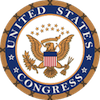 March saw the sales tax come under attack as states are looking to the federal government to lift the restrictions on collecting taxes on interstate sales. The senate re-introduced the Marketplace Fairness Act with lifts the restrictions on all interstate sales, not just those made via the Internet.
March saw the sales tax come under attack as states are looking to the federal government to lift the restrictions on collecting taxes on interstate sales. The senate re-introduced the Marketplace Fairness Act with lifts the restrictions on all interstate sales, not just those made via the Internet.
In March, the Supreme Court ruled that a challenge to Colorado’s so-called “Amazon tax” can proceed in federal court, Justice Anthony Kennedy suggested that that the court should re-examine the physical presence rules. As part of the court’s opinion on the Colorado case, Kennedy wrote that the ruling “now harms states to a degree far greater than could have been anticipated earlier.”
Remember, the overwhelming majority of coin dealers are small businesses. All of these attempts by the states to squeeze every last cent out of you will put a heavy burden on small businesses. If it costs too much for small businesses to manage these sales tax rules it could impact coin shows all over the country.
This one is going to get dicy. stay tuned!
In February, there was only one bill that saw any action:
S. 301: Boys Town Centennial Commemorative Coin Act
Sponsor: Sen. Deb Fischer (R-NE)
• To require the Secretary of the Treasury to mint coins in commemoration of the centennial of Boys Town
• Passed Senate without amendment by Unanimous Consent on March 24, 2015
• Sent to the House of Representatives for consideration (held at the desk) on March 24, 2014
Track this bill at https://www.govtrack.us/congress/bills/114/s301
The following two bills were introduced right before congress adjourned for their spring break and have not been published. While the Coast Guard commemorative is pretty self explanatory, H.R. 1698 is intriguing.
H.R. 1683: To require the Secretary of the Treasury to mint coins in commemoration of the United States Coast Guard
Sponsor: Rep. Joe Courtney (D-CT)
• Introduced on March 26, 2016 (106 co-sponsors)
• Referred to the House Committee on Financial Services
Track this bill at https://www.govtrack.us/congress/bills/114/hr1683
H.R. 1698: To amend design and content requirements for certain gold and silver coins
Sponsor: Rep. Bill Huizenga (R-MI)
• Introduced on March 26, 2016
• Referred to the House Committee on Financial Services
Track this bill at https://www.govtrack.us/congress/bills/114/hr1698
Apr 2, 2015 | fun
Did you get it? Did you figure it out? If you read yesterday’s post you would have discovered:
- H.R. 1776 has not been introduced in the 114th congress and there is no such bill as the U.S. Mint Restoration Act. But it sounded good!
- Even if the House of Representatives passed such a bill, it would still have to be voted on by the Senate and signed by the president.
- As for some of the actors in this play, House Financial Committee Chairman is Jeb Hensarling, not “Jim Hensling.” I don’t think they are related.
- anking member of the House Financial Committee is Maxine Waters, not Max Waterston. Max is not related to Sam
- Janet Yellen is a home girl (Brooklyn born, like your blog host) and Chair of the Federal Reserve Board of Governors. I’m sure Jan Yelling is a nice person, but she’s not running the Fed.
- In an attempt not to use “Rhett Butler,” Rhett Jepson is the U.S. Mint’s Principal Deputy Director. I don’t know who Jett Butler is—but he sounds like he should be a kicker or something.
- Rosie Rios is a very nice person and is the Treasurer of the United States. Rosalind Rio could be her evil twin, but that is not confirmed.
- Finally, Jake Lou sounds like a good-ol’ boy, but he is not the Secretary of the Treasury. Jacob “Jack” Lew is the man in that job probably way too busy for this stuff.
In short:

Like the Orson Well’s broadcast of The War of the Worlds, all you had to do is change the channel (or check another source).
That was fun!
Now back to our regular numismatic content.
Apr 1, 2015 | fun
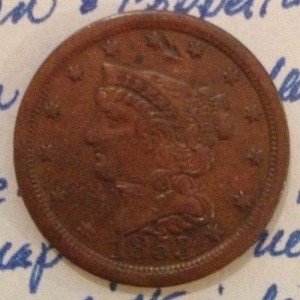
1853 Braided Hair Half Cent Obverse – The last half-cent before being revived for 2016.
Starting in 2016, the U.S. Mint will be required to produce the half-cent, two-cents, three-cents, and 20-cents coins using the designs that appeared last on those coins. To save money, the half-cent will be made of copper-coated aluminum while the two-cent coins will be similar in composition with the current Lincoln cent. Three-cent coins will be made of copper-nickel with ratio of 75-percent nickel to 20-percent copper and 5-percent zinc. The 20-cents coins will be a clad coin with no reeds on the edge.
-
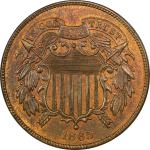
-
1865 Two Cents
-

-
1866 Three-cent nickel
-
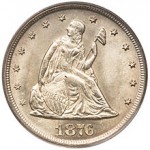
-
1876-CC Twenty cents
Claiming that they are being faithful to the constitution, Financial Committee Chairman Jim Hensling said that to bring back these coins would not only increase the options for the American public but that the seigniorage earned from making these coins would go a long way to help balance the budget. Speaking with Hensling, Ranking Member Max Waterston was optimistic that this would provide needed relief for low-income people looking to save their change.
The measure was supported by supported by Jan Yelling who also expressed concern that the coin rooms were overflowing with unused dollar coins. However, with expansion at many of the Federal Reserve member bank’s coin rooms that there should not be a problem supplying the country with the new coins.
Looking a little forlorn at the announcement was the U.S. Mint’s Principal Deputy Director Jett Butler. On the job since January, Butler has to figure out how to ramp up production of these new coins in time to have them in circulation by 2016. However, we were assured by Treasurer Rosalind Rio that the U.S. Mint will have the resources to allow them to bring up the production levels to meet the demand.
Bringing back these old denominations will certainly introduce new collectibles to the numismatic community. It will also be an opportunity for the makers of folders and albums to add to their portfolio. It is possible that the result will introduce new people who will collect these coins and learn about the past and why these coins were originally part of the U.S. currency system.
Finally, in a statement read on behalf of Jake Lou, who could not attend, he applauded the work of congress and asked that they consider allowing the U.S. Mint to replace the paper one-, two-, and five-dollar notes with coins. Lou noted that the seigniorage on a five-dollar coin could be as much as $4.50, which could go a long way to help balance the budget. Hensling and Waterston were non-committal on the proposal.
Half-cent image courtesy of the author.
All other images courtesy of Wiki Media Commons.
 A few weeks after the Women on 20s group began their campaign, they gained the attention of congress to have two bills submitted to require the change be made.
A few weeks after the Women on 20s group began their campaign, they gained the attention of congress to have two bills submitted to require the change be made.


 During the course of searching for information, I stumbled upon the website for
During the course of searching for information, I stumbled upon the website for 

















 March saw the sales tax come under attack as states are looking to the federal government to lift the restrictions on collecting taxes on interstate sales. The senate re-introduced the
March saw the sales tax come under attack as states are looking to the federal government to lift the restrictions on collecting taxes on interstate sales. The senate re-introduced the 




